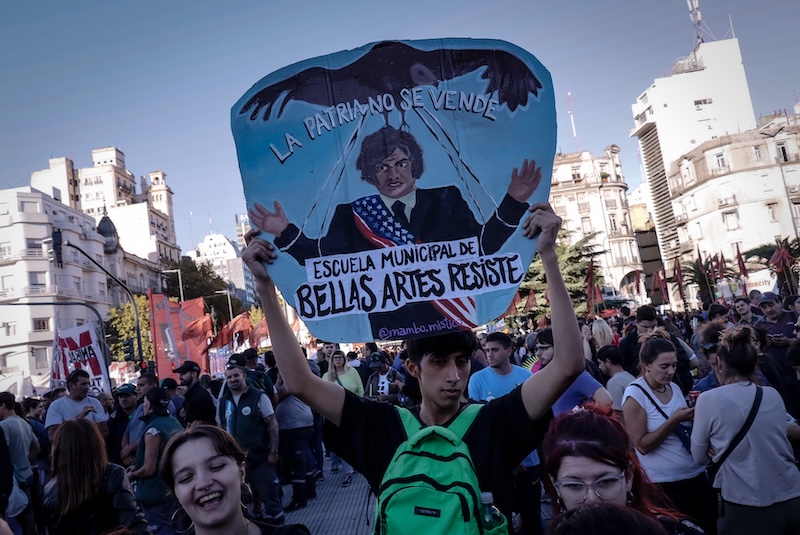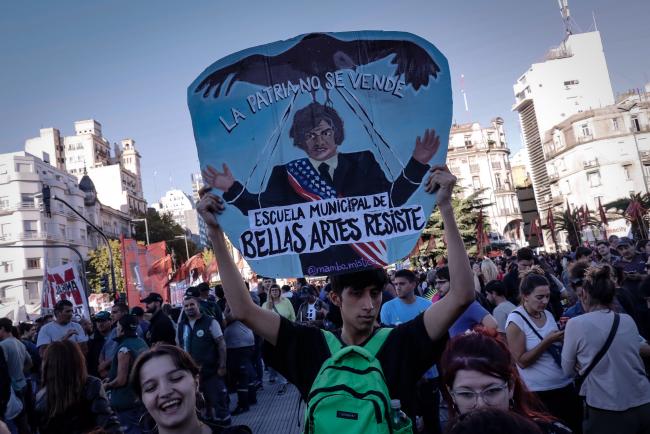
Check out the article in Spanish.
BHuenos Aires, Argentina. In front of the Casa Rosada, singing and jumping continued until the evening of April 23rd. “UBA protects itself” “Why are you so afraid of education?” el pueblo “(What about the people)?”, “Mirai, trash, you are a dictatorship”, ” Patria (My homeland) is not for sale! ” chanted the crowd in front of a fence erected to block the road to the Argentine government building.
Demonstrators waved flags and put up posters as a line of police officers stood on the other side of a metal wall.
These groups of protesters showed no signs of running out of energy, even after hours of protesting on the city's streets. They took part in one of the largest marches the country has seen in recent years, and the largest ever under President Javier Millay's government.
Together with thousands of others, they formed an unprecedented wave of at least 800,000 people who stood up to defend public university education.
They told Millais and his supporters that they were and would continue to be there to protect free public college education.
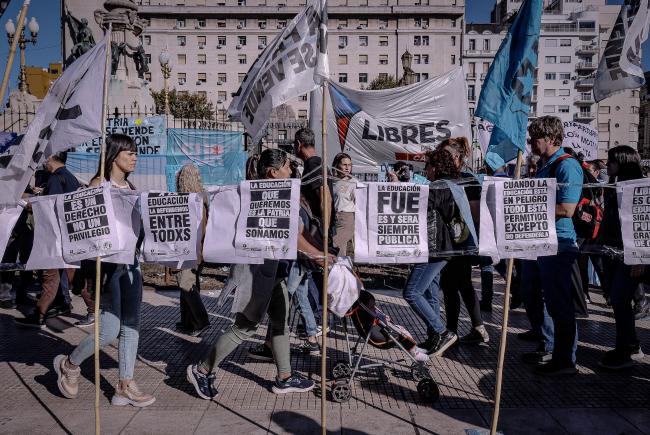
Public higher education in crisis
aIn early April, alarm bells were sounded about the risks facing public university education in Argentina. There were concerns about whether the Millais government would maintain the extension of funding allocated to public universities.
This extension does not take into account annual inflation, which equates to just over 270 percent. Therefore, according to Asociación Civil por la Igualdad y la Justicia (Citizens Association for Equality and Justice, ACIJ), cited by elDiarioAR, funding for universities has actually been cut by 70 percent.
Already on April 5, Emiliano Jacobitti, vice president of the University of Buenos Aires (UBA), the most prestigious university in the country and one of the most important in Latin America, pointed out that the situation could reach a breaking point. did. Mr Jacobitti warned that large parts of the university would be “closed within the second term” if Mr Millais' position did not change.
Ms. Millay has attacked public education several times. As a presidential candidate, he proposed abolishing compulsory education (primary and secondary education). Speaking at the IEFA Latin America Forum last March, a gathering of business leaders in the energy sector, he said public education was “doing great damage by brainwashing people.” He was particularly critical of UBA's Faculty of Economics.
Tensions continue to rise, and on April 10th, U.B.A. Consejo Superior (High Council) declared a state of budget emergency and agreed to participate in the National Federal University March scheduled for April 23rd.
“In the current situation, the possibility of maintaining all activities aimed at ensuring the quality of education and continuing research, extension and support functions is seriously affected,” UBA said.
The call for the march was promoted by the Frente Sindical de Universidades Nacionales (National Universities Union Front), Federación Universitaria Argentina (Federation of Universities of Argentina, FUA), and Consejo Interuniversitario Nacional (National Interuniversity Council, CIN). Gradually other sectors of society (trade union organizations and groups) also supported this call.
Activities leading up to the march included a vigil, public classes, and cultural events. The university demonstration was replicated in other states of the country on the same day, April 23rd. The entire university system is at risk. There was no further reaction.

an attempt to silence dissent
IThe ruling party claimed it had political interests in response to the call for a march.other They promoted the call for a march more than the students.
Additionally, tensions persisted regarding the security of mobilization. There were fears of a crackdown, as happened in January during demonstrations against a so-called omnibus law that called for deregulation of the country's economy.
After taking office in December 2023, the liberal Millais began promoting a range of policies, including the layoffs of thousands of employees from various public institutions and cuts in salaries and pensions. It is worth remembering that this has been done and that thousands of people have been affected as well. They still blame the food crisis today.
Anticipating protests against the new measures, Millais's government introduced anti-picketing laws when it first took office, banning road closures and blockades. The regime deployed federal police. Gendarmeria (National Frontier Guard), and prefecture (Navy) This was in response to various protests, all of which were peaceful.
However, the Autonomous Municipality of Buenos Aires (CABA), which is responsible for security in the capital, gave permission for the march. Therefore, National Security Minister Patricia Bullrich's operations were only developed around federal buildings such as Casa Rosada. Metal fencing was erected there and police remained stationed there.

Far from “settled”
TOn the eve of the mobilization for public university education, Millais broadcast a recorded message on national television. He asserted that the economic policy of gradual dismantling of the state was yielding positive results. He said the budget surplus was achieved thanks to government budget cuts and other measures.he said the following “Hazanya Mundial” (a world-class accomplishment), and fiercely criticized the previous government.
He also said the university's problems were “resolved” as a deposition was taken to update the university's operating budget.
His closest staff and those at Casa Rosada also maintained the position that the university issue was “resolved.” Despite mass demonstrations, they chose to insist that nothing has changed and that the interests of the government's opponents are at risk.
The fight over public university education in Argentina is not new. In different episodes and under different political leaders, students protested to protect their right to education. This right has never been so threatened during Argentina's post-dictatorship era of democracy, which began in 1983.
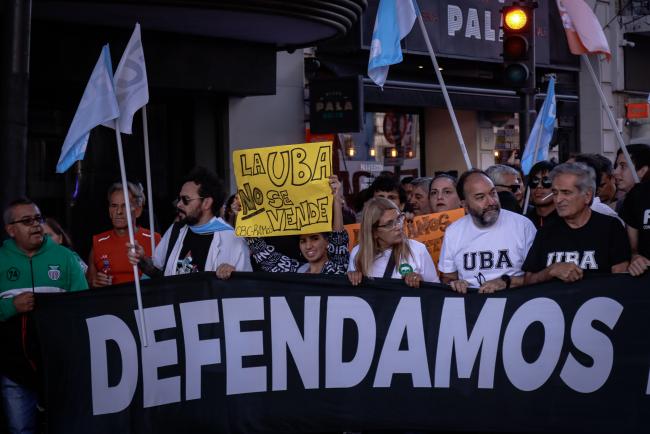
“Without university, there is no future.”
BYoung students, drummers, retirees, trade unionists, families, and various groups of people packed into the area near the Palace of the National Assembly and Plaza de Mayo, the starting and ending points of the mobilization. They put up stickers, posters and stencils. They chanted, “Protect education'' and “Education belongs to people.'' Elle pueblo“We will protect it”, “Without science, there is no Conan” (All five of Millay's dogs are clones of his beloved dog, Conan, who died in 2017), “Without university, There is no future.”Let's take to the streets so we don't lose our classrooms.”
The message has doubled. So was the screaming. Various scenes occurred in the crowd. One parent said she sees her child struggling for more opportunities in the future. The child excitedly pointed at the demonstrators passing by.
On 9th of July Street, a group of friends set off blue and red flares and jumped around while playing drums.
A group of veterans gathered on Callao Street. They looked at each other, smiled, and pulled out some books from their bags. “Look, I thought it was wise to have a constitution.” “I brought this with me. It's one of the books I read when I started college.”
A man appeared on his balcony and began clinking pots to encourage marchers. In response, the young people began clapping their hands, and a sonic dialogue was born.
”Che, there are a lot of us, we can't go any further. I’m running out of breath, but it’s good that you know we’re here,” said an older man as he walked toward the Cabildo public complex.
A street in one of the most emblematic areas of Buenos Aires became the scene of another iconic moment in the war. Elle pueblo argentina (Argentinian).
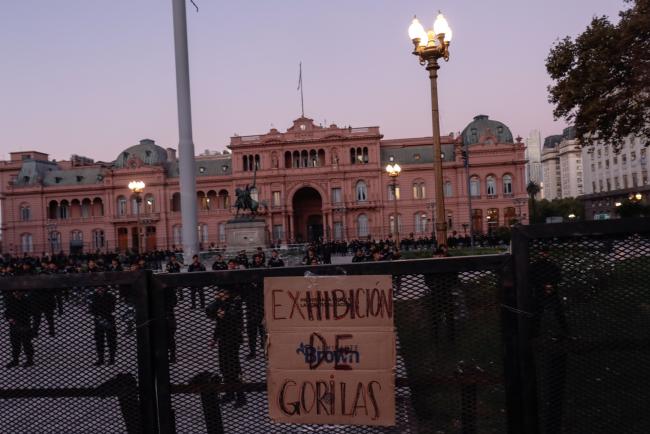
“Education sets us free”
IIf there's one thing that unites different sectors of society, it's advocacy for public education. Many contributors noted that this right has made social mobility in the country possible. “Thanks to UBA, I have a high-quality job today.” “I was the first in my family to go to university. I don't want to be the last.”
Many social leaders rallied to support the students. The closing rally in Plaza de Mayo was attended by trade union leaders, academics, mothers from Plaza de Mayo, and others. They outlined what happened during the first four months of the Millais government and talked about setbacks and problems. But they continued the struggle and called on people to join the cause.
“I also studied at a public university,'' several people said, as cheers rang out.
”Education of Salva and Hass Libre (Education saves us and sets us free). We call on Argentine society to protect Argentine society,” said Piera Fernández de Piccoli, president of the Argentine Universities Federation, from the podium.
In broadcasting the victory the night before, Millais said, “The era of the present nation is over.” Of course, that's not why he said such things, but the crowds that gathered to defend education showed that Argentina was indeed entering a new era, and that It will resonate. ”Calajo, Viva La Universidad. ”
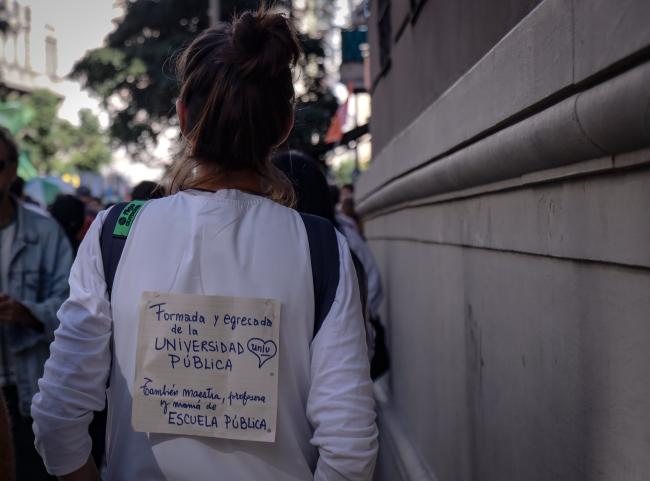
lisbeth hernandez I am a freelance journalist and photographer from Mexico. Covers social movements, human rights, feminism, LGBTI+ issues, immigration, women, and territorial defense in Mexico and other Latin American countries. She has worked with The Washington Post, El País, Aj+ en Español, NACLA Report, Alharaca, Presentes, Wambra, Animal Político, Contracorriente, Volcanicas, and more.


